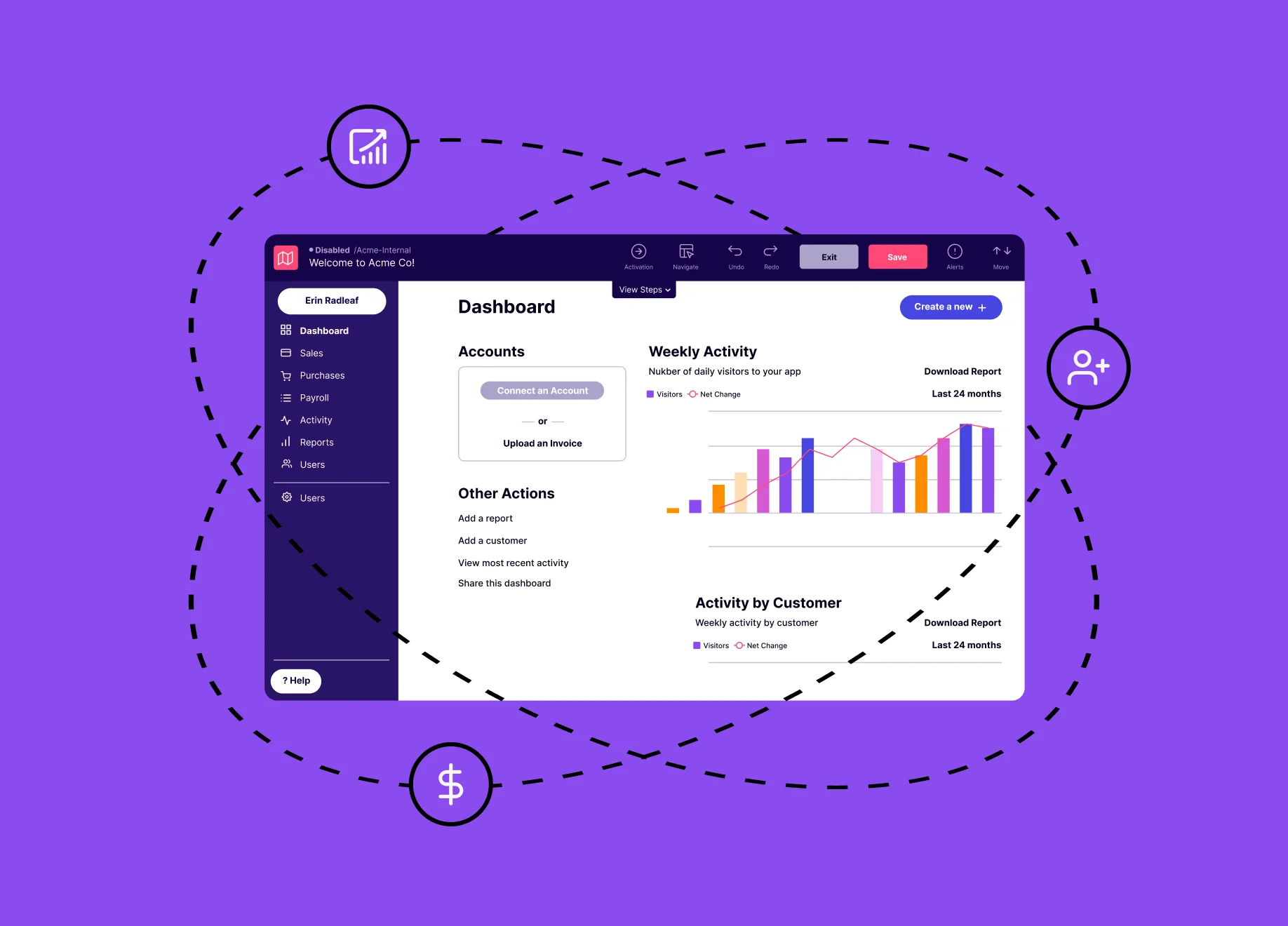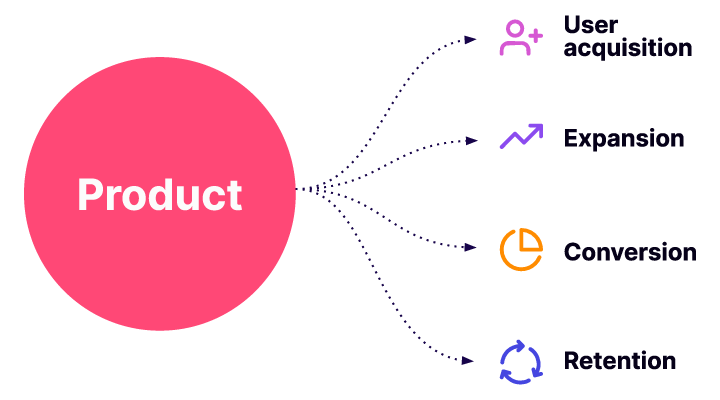Table des matières
Que désigne la croissance axée sur le produit » ?
Product-led growth describes a business strategy that places a company’s software at the center of the buying journey—and often at the center of the broader customer experience. A product-led growth strategy counts on the product itself—its features, performance, and virality—to do much of the “selling.”
Qu'est-ce qui rend la croissance axée sur le produit unique ?
Le principal facteur de différenciation de la croissance axée sur le produit est qu'elle place le produit au centre de tous les efforts de mise sur le marché. Les équipes chargées des ventes et du marketing réorientent ainsi leurs efforts pour laisser le produit (et les échos positifs qu'il génère) mener les opérations.
Prenons l'exemple des entreprises qui proposent un produit freemium : celui-ci sert d'outil commercial et marketing en attirant de nouveaux utilisateurs sans avoir à investir dans des campagnes publicitaires ou à recruter des commerciaux supplémentaires. De même, les stratégies de croissance axée sur le produit permettent souvent aux utilisateurs de découvrir un produit gratuitement en leur dévoilant suffisamment de valeur pour les encourager à passer à la version payante.
Pourquoi la croissance axée sur le produit est-elle importante ?
As companies grow and the amount of customers and prospects it engages with expands, a 1:1 human-to-human support and sales model becomes less and less sustainable. Product-led growth helps companies continue to scale and grow efficiently by automating some of the key onboarding, support, sales, and marketing functions and letting customers and prospects engage with them in the app itself. In doing so, it frees the humans in a company up to pursue more strategic, meaningful work while having confidence that users of all categories are getting the support and information they need. In other words, product-led growth is not a substitute for human support and ingenuity, but rather a complement to it.
5 stratégies PLG qui contribuent au succès de votre entreprise
Quelle est l'histoire de la croissance axée sur le produit ?
The term “product-led growth” was originally coined in 2016 by Blake Bartlett at OpenView, although the principles that define it had been around before that. What drove the rise of product-led growth were companies experimenting with various ways (“freemium” product models, self-guided tours, etc.) to simultaneously grow and be profitable. In traditional growth models, growth and profitability existed as a dichotomy. Pursuing one came at the expense of the other. Product-led growth overcame this dichotomy, with the companies embracing the tactics and strategies that would become associated with the term seeing unprecedented levels of success in both.
Comment les périodes d'essai en libre accès et le freemium stimulent-ils la croissance axée sur le produit ?
Often central to a product-led growth strategy is a self-service trial or freemium option that allows a prospective customer to evaluate the product independently and without charge, bounded by time and/or functionality, and often without engaging a salesperson. This self-service approach aligns to shifting changes in buyer preferences, particularly in the research and evaluation phases of the buying journey. Many buyers want to try before they buy, relying less on a salesperson’s assistance than on their own first-hand experience with the product, in conjunction with customer and social proof that they discover via review sites and social networks.
Many companies use these trial and freemium experiences to measure product usage and engagement, scoring leads and timing and targeting conversion offers and sales outreach accordingly. Citrix, for example, used product analytics to identify a certain trial usage pattern that converted to paying customers at a higher rate than others. The team then created an onboarding flow that steered trial users toward those particular features, and was able to increase their trial conversion rate by 28 percent.
Voici comment OpenView, une société de capital-risque de premier plan spécialisée dans les entreprises de logiciels en phase d'expansion, considère l'importance de la croissance orientée produit et le modèle freemium qui en découle :
Comment la croissance axée sur le produit permet-elle de réduire les coûts d'acquisition des clients ?
Une stratégie de croissance axée sur les produits peut avoir un impact positif sur le coût d'acquisition des clients (CAC) en réduisant la charge de travail des équipes de vente. Les dépenses de vente et de marketing contribuent aux coûts d'acquisition des clients, donc plus une entreprise peut réduire lesdites dépenses, plus ses indicateurs d'efficacité tels que le CAC se porteront bien.
Qu'est-ce qu'une stratégie de croissance axée sur le produit ?
Une telle stratégie place le produit au centre du modèle de croissance d'une entreprise. En pratique, elle varie selon l'entreprise. Il peut s'agir de fixer des objectifs pour des indicateurs de croissance clés : pourcentage de nouveaux revenus, nombre ou pourcentage de pistes de nouvelles opportunités, augmentation des fonctionnalités ou de l'utilisation dans les comptes existants, etc. Ces indicateurs sont obtenus grâce à des tactiques axées sur le produit, telles que des versions freemium, des démonstrations autoguidées et des notifications dans l'application soulignant les nouvelles fonctionnalités et offres de produits. Plus le produit lui-même stimule les ventes, le marketing et l'assistance, plus une entreprise penche vers une stratégie axée sur le produit.
Comment appliquer la croissance axée sur le produit à la stratégie de mon entreprise ?
Product-led growth is a subset of a broader product-led strategy, which expands beyond the try/buy phase of a self-service buying journey to include other touch points, pre- and post sales, where the product takes center stage. For example, a product-led strategy may also mean bringing aspects of sales, marketing, service, support, and education inside the product for convenience, reduced friction, and greater contextual relevance to end users. Here, business functions and customer interactions that were previously executed through other channels converge inside the product, all toward the goal of making the product more useful, more engaging and, ultimately, more valuable for customers and end users.
Quels sont les exemples de croissance axée sur le produit ?
Different companies embrace product-led growth in different ways. Citrix, for example, created personalized onboarding messaging for the free trial version of its ShareFile product based on the reasons users created an account. Using in-app messaging to speak to users’ specific needs, they saw a 60% increase in free trial conversions. Covetrus, meanwhile, leveraged product analytics to better understand user behaviors, created in-app guidance and onboarding based on those insights, and solicited feedback in-app so that customer priorities became their own.
Où peut-on en apprendre plus sur la croissance axée sur le produit ?
Pendo published a comprehensive e-book on how to create a product-led organization, which is available for download here. It has also created a Product-led Hub full of insightful content on leveraging a company’s product to drive growth and a stronger business.
Using product-led strategies to improve customer retention and expansion






